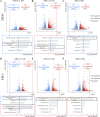Combinatorial targeting of a specific EMT/MET network by macroH2A variants safeguards mesenchymal identity
- PMID: 37432970
- PMCID: PMC10335705
- DOI: 10.1371/journal.pone.0288005
Combinatorial targeting of a specific EMT/MET network by macroH2A variants safeguards mesenchymal identity
Abstract
Generation of induced pluripotent stem cells from specialized cell types provides an excellent model to study how cells maintain their stability, and how they can change identity, especially in the context of disease. Previous studies have shown that chromatin safeguards cell identity by acting as a barrier to reprogramming. We investigated mechanisms by which the histone macroH2A variants inhibit reprogramming and discovered that they work as gate keepers of the mesenchymal cell state by blocking epithelial transition, a step required for reprogramming of mouse fibroblasts. More specifically, we found that individual macroH2A variants regulate the expression of defined sets of genes, whose overall function is to stabilize the mesenchymal gene expression program, thus resisting reprogramming. We identified a novel gene network (MSCN, mesenchymal network) composed of 63 macroH2A-regulated genes related to extracellular matrix, cell membrane, signaling and the transcriptional regulators Id2 and Snai2, all of which function as guardians of the mesenchymal phenotype. ChIP-seq and KD experiments revealed a macroH2A variant-specific combinatorial targeting of the genes reconstructing the MSCN, thus generating robustness in gene expression programs to resist cellular reprogramming.
Copyright: © 2023 Valakos et al. This is an open access article distributed under the terms of the Creative Commons Attribution License, which permits unrestricted use, distribution, and reproduction in any medium, provided the original author and source are credited.
Conflict of interest statement
The authors have declared that no competing interests exist.
Figures




References
Publication types
MeSH terms
Substances
LinkOut - more resources
Full Text Sources
Molecular Biology Databases
Research Materials
Miscellaneous

